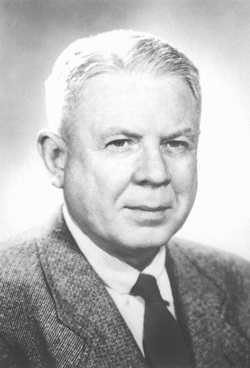Carl McFarland - 1951-1958
Carl McFarland
March 1951 - May 1958
"If there is any clue to the operation of this University it is the matter of standards."
Education
- B.A., The University of Montana, 1928
- M.A., The University of Montana, 1929
- LL.B., The University of Montana, 1930
- S.J.D., Harvard University, 1932
Accomplishments as President
In his time as President, McFarland managed to leave a number of legacies behind. His administration launched a massive campaign to expand the University campus. In addition to building structures, McFarland acquired several plots of land later used for research and expansion. A number of campus organizations including The Montana State University Press, a University Credit Union, The Montana Science Fair, and the Bureau of Government Research began. At this same time, the Western Interstate Commission for Higher Education started, saving UM expenses and offering more opportunities to students. Academic curricula became reorganized, separating departments and establishing new degree programs. McFarland also worked to emphasize the arts, spurring an increase in dramatic and musical productions. In 1950, The University of Montana Foundation was formed, functioning as a non-profit organization to receive grants and donations given to the University.
Background History
In 1932, McFarland left Harvard and returned to Montana. He worked as a member of a Helena law firm and also as a clerk and commissioner for the Montana Supreme Court before being assigned to the Anti-Trust Division of the Department of Justice in Washington D.C. In 1937, he became an assistant Attorney General for Franklin D. Roosevelt. After resigning to practice private law, he was awarded the ABA medal by the American Bar Association in 1946.
Following the Presidency
After leaving UM, McFarland joined the faculty of the University of Virginia Law School. He then served as a consultant to the Virginia Commission on Constitutional Revision and chairman of the 1968 United States Public Law Revision Commission. McFarland retired to Virginia in 1975 and lived there until his death four years later.

Landmarks Erected
- Craig Hall, 1952
- Field House (Adams Center), 1953
- Women's Center (McGill Hall), 1953
- Music Building, 1953
- Liberal Arts, 1953
- Ryman Addition, 1955
- Robert B. Curry Health Center, 1955
- The Lodge, 1956
- North Corbin Hall, 1956
- Art Annex/Grizzly Pool, 1957
- Duniway Hall, 1957
Programs Established
- College of Fine Arts
- Programs in Liberal Arts, Radio/Television, and Drama
- Courses in Russian, Italian, Dance, and Physical Therapy
- ROTC
